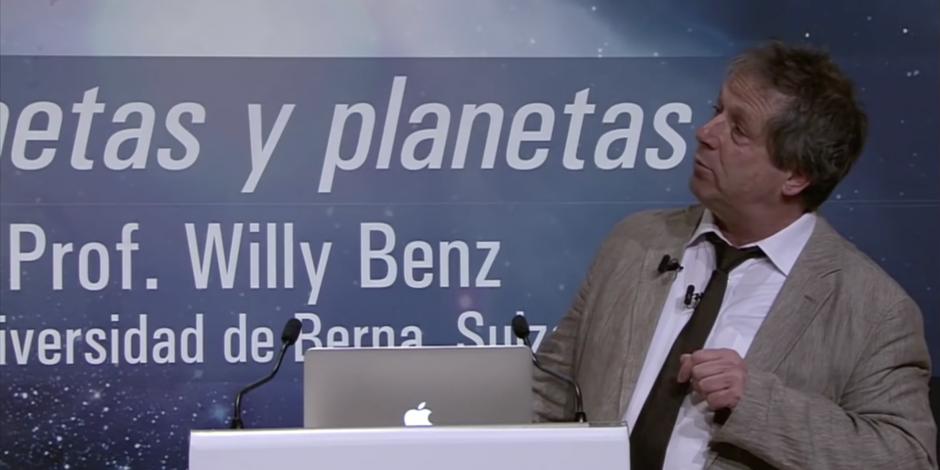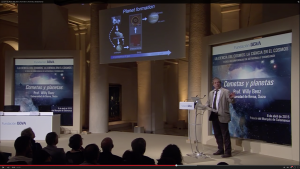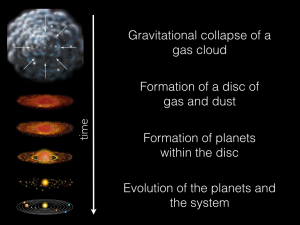A cosmic detective story

«Comets give us good clues that the planet formation era was violent and the early solar system very different from today,» said Willy Benz, director of PlanetS, at a conference in Madrid.

«Comets and Planets» was the title of Professor Willy Benz’ opening talk at a lecture series in Madrid on 8 April 2015. Credit: BBVA Foundation
«Comets were born during the formation of the solar system in the first 10 to 100 million years», explained Willy Benz in his opening talk of a lecture series organised in April 2015 by the Spanish foundation BBVA and addressed to a wide audience. «These objects are stored in the freezer for 4,5 billion years far away from the Sun.» By chance some of them penetrate into the inner regions of the solar system. Their primeval condition makes them especially interesting for science.
«You can look at this like a detective story,» said Willy Benz. «You collect data, you have evidence and then you try to reconstruct what has happened a long time ago.» The scientists’ evidence are measurements of the comets’ orbit, shape, composition and material properties as well as the number statistics and the family membership. These data allow drawing conclusions about the formation of the planets in the early solar system. What makes the cosmic detective work more difficult than solving a crime is the time scale. «It takes 4,5 billion years of history to trace back and you have only very few clues to do this,» explained Willy Benz, director of PlanetS and the Physics Institute of the University of Bern.
A body half empty
So far only six comets have been closely studied by a spacecraft. From measurements taken by the Rosetta mission we know that comet 67P/Churyumov-Gerasimenko has a very low density. «This object would float on water, it is more than half empty,» said the astrophysicist. «And it is not a nice, smoothly blended ice cream but a more complex heterogeneous mixture of ice, dust and whatever else there might be.» After the first readings of the chemical composition of the ice it is also clear that comets are unlikely to be the main source of water on the Earth as previously thought. «Now the trendy thing is to look for water in the asteroid belt,» said Willy Benz. «Asteroids are the next suspects on the list.»
Rosetta is a key actor in collecting data to be able to reconstruct what has happened long ago. According to theory it all started with a gravitational collapse of a gas cloud. A disc of gas and dust was formed. Within this disc the dust was concentrated, planetesimals and planetary embryos were growing that finally formed giant or earth-like planets. «Bodies of cometary size are the building blocks of planets,» summarized Willy Benz. «Those not accreted by a planet have been either lost or stored in deep freeze for billions of years.»
Playing pool with comets
Already in 1950 the astronomer Jan Oort postulated that there must be a big comet reservoir at a large distance – it is now known as the Oort cloud. To understand how this was formed you have to play pool, the Swiss expert recommended. When a small object encounters a planet it gets a kick and leaves its original orbit with higher velocity. «Such encounters were the mechanism that sculptured the solar system,» said Willy Benz. «This mechanism kicked the comets out so far and put them in the deep freeze storage.»
A computer simulation, the «Nice model» named after the French city where it was first presented, demonstrates a possible scenario in the early solar system. It starts with the giant planets Jupiter, Saturn, Neptune, Uranus and a lot of small objects further out, that orbit the Sun. Simulating the first few hundred million years nothing spectacular happens. «But when you get to 880 million years the thing explodes because Jupiter and Saturn have crossed their 2:1 resonance,» explained Willy Benz. During this dramatic event most of the little objects are thrown out at large distances or are lost from the solar system, or even collided with planets and moons.
Migrating giants
This computer simulation shows that the solar system was very different in the early days. «It doesn’t work with the solar system we have now,» said Willy Benz. «We have to start with something different; that is part of this detective story.» Another possible piece of the reconstruction is the so-called Grand Tack model. It shows what could have happened even earlier on. In this scenario, Jupiter migrated inwards and came nearly as close to the Earth as Mars is today! «But that was before the Earth existed,» the expert explained, «so lucky for us.» The simulation demonstrates how at some point Jupiter followed by Saturn migrates back out and the situation remains unchanged until the instability showed by the Nice model kicks in 800 million years later.
«What we have learned from the statistics, dynamics and characteristics of comets is that the formation time of our solar system was violent,» summarized Willy Benz at the conference in Madrid. There were a lot of dramatic events that happened in those days and the planets we see today have not been in the same place in the past. «You may conclude that it is getting really complicated,» the astrophysicist admitted: «Maybe we are on the wrong track. That is why the story is not over and that is why real detective work doesn’t finish in 45 minutes like on TV.»
Video of the lecture at the BBVA Foundation on 8 April 2015 in Madrid:
https://m.youtube.com/watch?v=4_PiDBU1dtM
Categories: News


